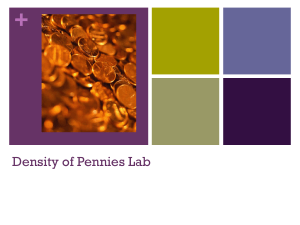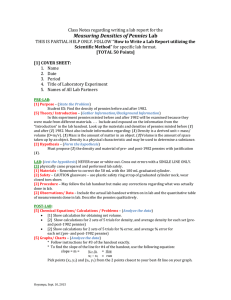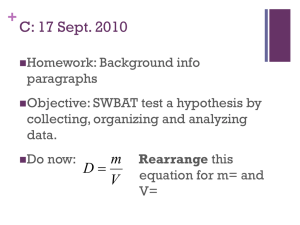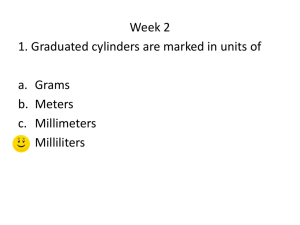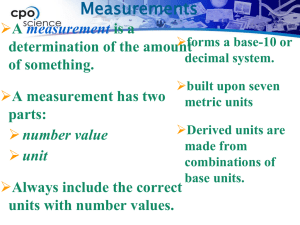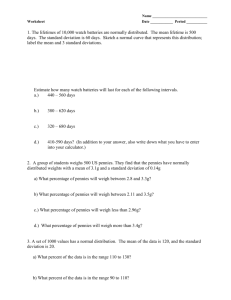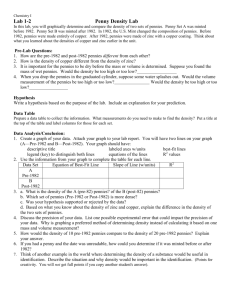Density of Pennies Lab
advertisement
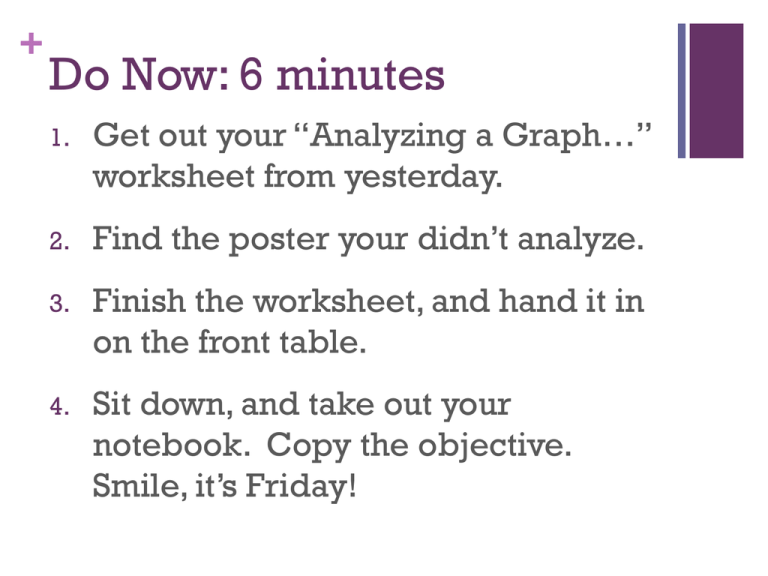
+ Do Now: 6 minutes 1. Get out your “Analyzing a Graph…” worksheet from yesterday. 2. Find the poster your didn’t analyze. 3. Finish the worksheet, and hand it in on the front table. 4. Sit down, and take out your notebook. Copy the objective. Smile, it’s Friday! + Density of Pennies Lab + Intensive vs. extensive properties Intensive property: a physical property that does NOT depend on how much of a substance you have. Ex: temperature, velocity, melting point Extensive property: a property that DOES depend on how much you have. Ex: mass, length, volume + Intensive or extensive? I weigh 130 pounds. The car is moving 50 miles per hour. The length of a marathon is 24.6 miles. The Ice I density of water is 1.0 g/mL melts at 0oC. drank one liter of soda. (burp!) + Density A physical property of matter mass(g) density 3 volume(mL /cm ) The mass per volume of a substance. Units: g/mL 1 or g/cm3 mL = 1 cm3 + Calculate Density Mass 10.0 = 10.0 g, volume = 20.0 mL g, 5 cm3 Calculate the mass of a sample of matter with a volume of 10.0 cm3 and density of 2.0 g/cm3 Calculate the volume of a rock with mass 100.0 g and density 5.00 g/mL. + Homework Week 6 Homework, #5-6 + The phenomenon In 1982, the density of pennies changed. + Your challenge: Determine, empirically, the density of pennies before and after 1982. 1. Write a materials list and procedure. Include ALL your steps. Be thorough! 2. Carry out your procedure. 3. Record and organize data into a chart and graphs. Describe your data in a paragraph. 4. Analyze your data in a paragraph. 5. Make a conclusion summarizing your data and answering questions. + Some details How can you determine the volume of a penny? Displacement Calculate the density of 2, 3, …10 pre1982 pennies, and 2, 3, …10 post-1982 pennies. Make a neat table and graph. + + An example of a good table. Table 1: Mass, volume and density of pre-1982 pennies Number of pennies 2 3 4 5 6 7 8 9 10 Mass (g) Volume (mL) Density (g/mL) + Things to write in your notebook: An excellent materials list and procedure Complete data tables (title, headings, units, calculations, NEATLY!) Complete graphs: mass vs. volume and EITHER mass vs. density or volume vs. density, with title, axis labels and units A written description of your data. A written analysis of your data A conclusion based on guiding questions. + Your homework To write a lab report. First Draft (neatly hand-written or typed) due: + So, is density intensive or extensive? How do you know? Discuss your graph, and what a graph of the other type might look like. + By the end of class… Materials list and procedure (incl. how to make calculations!) Data table for pre- and post-1982 pennies 2 graphs: mass vs. volume AND either Mass vs. density OR volume vs. density With a sentence describing each graph. You can start an analysis and conclusion like we practiced yesterday. + Homework Week 6 Homework: #5-6 2 graphs: mass vs. volume AND either Mass vs. density OR volume vs. density With a sentence describing each graph. You can start an analysis and conclusion like we practiced yesterday. Mass vs. Volume of Pre- and Post-1982 Pennies Pre-1982 Pennies Post-1982 Pennies 4 Volume (mL) 3.5 3 2.5 2 1.5 1 0.5 0 0 5 10 15 20 Mass (g) 25 30 35 Mass vs. Density of Pre- and Post-1982 Pennies Pre-1982 Pennies 10.0 Post-1982 Pennies 9.0 Density (g/mL) 8.0 7.0 6.0 5.0 4.0 3.0 2.0 1.0 0.0 0 5 10 15 20 Mass (g) 25 30 35 + With your group: Fix your graphs. Draw a best-fit line. Write a one-paragraph analysis for each graph. Describe BOTH lines for each graph. Trend Shape of line Outliers: points that are way off the line. + Title Your lab report should be titled with a title of your choosing. It should be relevant to the lab and should not just be the same as the title of a handout your teacher gave you. Do not have it on a separate title page. + Background Information Explain any important concepts that are central to understanding the experiment. In paragraph form, define any scientific terms necessary for understanding the lab. + Objective (NO hypothesis) Explain what the purpose of the experiment or what goals you have in completing the lab. What do you hope to accomplish? (No hypothesis) IV: number DV: density of pennies + Write a Lab Report Title (incl. name, data, partner’s names) Objective (no hypothesis) Background DUE info (from notes, etc.) TOMORROW + Procedure For a lab where you have designed the procedure, include a detailed and complete account of every single step you completed during the lab, including how to make calculations. Be sure to include proper names for pieces of equipment! If you have followed a procedure given by your teacher, write a summary of what you did. Do not rewrite the given procedure word for word. + Data and Results Include any charts, graphs, tables, technical drawings, observations, or diagrams in this section. Include a one sentence caption for each. Data should be presented neatly, and with the use of computer software when possible. If any calculations were necessary during this lab, include them here. DO NOT explain the data. + Analysis Describe any patterns or trends in the data. Point out any relevant characteristics and comparisons that you see. Do not attempt to explain them, simply note them. Note the existence of any data that does not seem to fit the overall patterns/trends. + Conclusions Draw conclusions from the patterns and observations you noted in the analysis section. Explain why the patterns you saw occurred. Was the experiment successful at completing the objectives above? Explain why or why not. Reflect on your hypothesis. Was it correct? Why or why not? Was there any significant error in your experiment? Propose some possible sources of error and explain how they might be improved. Answer questions (4) in lab handout in paragraph form. + On a separate sheet of paper… Write the first draft of your lab report. Work on your own. You may listen to music as long as I can’t hear it. Label each section. Be careful to include EVERY part listed in your lab report guide. First draft due: next Thursday, Oct. 22
